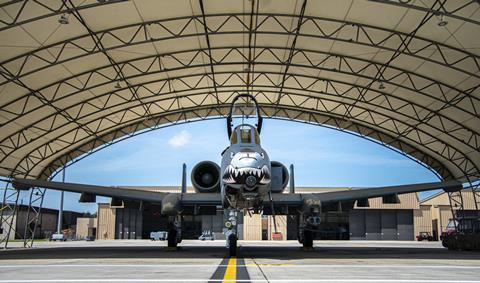The US Air Force (USAF) has finally begun the long-sought retirement of its Fairchild Republic A-10 Thunderbolt II ground attack jets.
The service said on 10 April it had retired the first A-10C, commonly known as the Warthog, from the 74th Fighter Squadron at Moody AFB, Georgia, after the airframe had logged 43 years of operational service.

A-10 tail number 80-149 was flown to USAF’s aircraft “Boneyard” at Davis-Monthan AFB in Arizona on 5 April, where it will be “preserved as much as possible, while also providing parts to other A-10s”, the service says.
This is the first of 21 A-10s that will be retired before October, the Air Combat Command (ACC) tells FlightGlobal. The ACC says it is prioritising the “least combat effective” A-10 airframes for retirement first.
The retirements must be completed during the current fiscal year 2023, per the current defence authorisation bill passed by Congress, which ends on the last day of September.
”This is bitter-sweet – it’s an old aircraft and there comes a time when each of them need to be retired,” says Staff Sergeant Austin Bryne, a dedicated crew chief with the 74th Fighter Squadron. “They are still combat-capable, but after all the hours put in, their time comes,” he adds.
When it touched down at the Boneyard, tail number 80-149 had recorded 14,125 flight hours over the course of its career.
The USAF has gone to considerable lengths to keep the Cold War-era A-10s flightworthy in recent years. The service contracted with Boeing in 2011 and 2019 to produce all new wing sets for its 283-aircraft A-10 fleet.
Each set consists of an outer wing assembly, centre wing assembly, control surfaces and fuselage integration kits. The upgraded wings are more durable, easier to maintain, and are supposed to last for 10,000h of flight, before needing a depot inspection, the USAF says.
While new A-10 production ended in 1984, the wing sets from the Enhanced Wing Assembly replacement programme are meant to extend A-10 flying life into the 2030s.
Despite that investment, USAF leaders have repeatedly sought to retire the A-10, which they say is too slow and unstealthy to survive against modern air defences.
The service’s top generals argue funds directed to maintaining the USAF’s nine A-10 squadrons would be better spent on modernising their fleet with more fifth-generation aircraft, such as the Lockheed Martin F-35.
However, that desire was repeatedly thwarted by US Congress, which required the continued operation of A-10 squadrons through the defence budget.

The aircraft gained cult status among American ground combat troops for its low-level gun runs while providing close air support during the lengthy wars in Iraq and Afghanistan. That in turn helped the famously rugged A-10 survive years of Washington budget politics. However, in late 2022 lawmakers finally approved the USAF to retire 21 of the turbofan-powered attack jets, starting in 2023.
Designed to destroy tanks in close air support, the A-10 was built around a titanium “bathtub” cockpit to protect the pilot, and a General Dynamics 30mm GAU-8A Avenger cannon. It uses two GE Aviation TF34-100 engines mounted prominently above the tail section of the aircraft, and can carry up to 7,200kg (16,000lb) of mixed ordnance, according to Boeing.
Tests performed by the USAF in 2022 determined that the A-10’s main cannon is still effective against the armour of modern main battle tanks, some 50 years after the aircraft was designed.
The type’s pilots still believe it has a role to play on the modern battlefield.
“The A-10s remain the most effective close air support platform in the world today even after 45 years,” says USAF Captain Kevin Domingue, who flew tail number 80-149 to its retirement.
“As long as the air force allows the aircraft to fly and be properly maintained, this community is ready to provide that expertise anywhere in the world against any adversary.”
The 74th Fighter Squadron has already received a replacement airframe for the retired 80-149. That aircraft was transferred from the Indiana Air National Guard, which currently operates A-10s, but is transitioning to the Lockheed F-16 strike fighter.


























